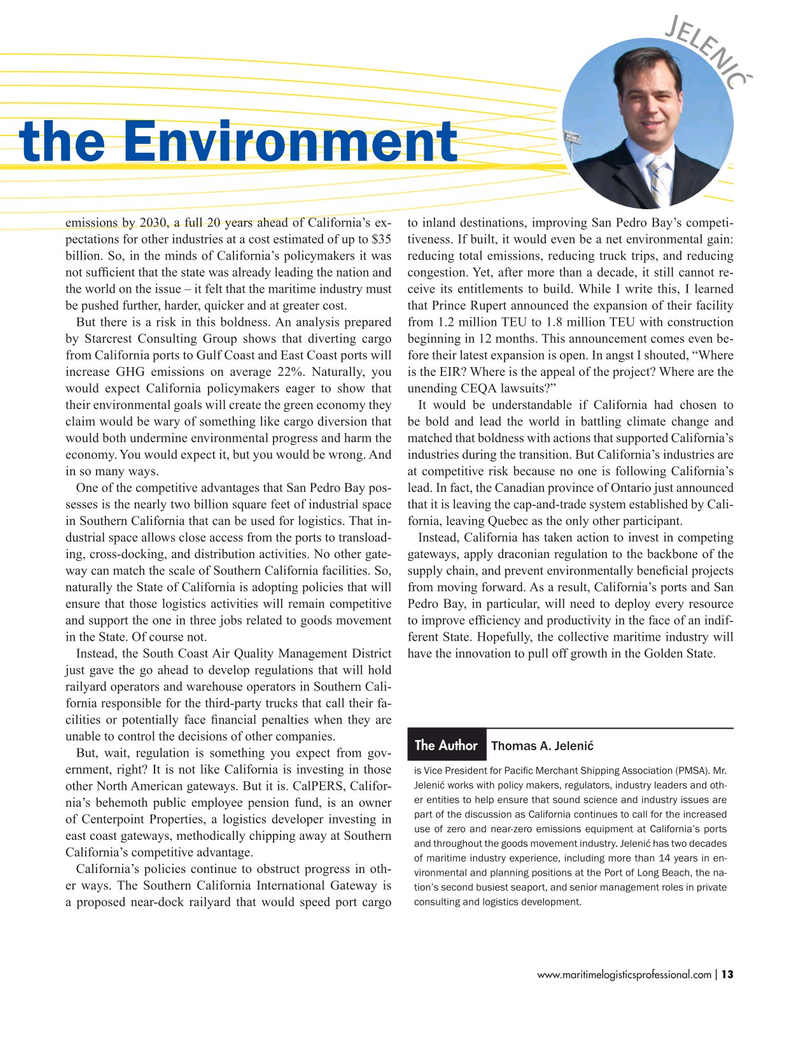
Page 13: of Maritime Logistics Professional Magazine (May/Jun 2018)
Container Ports
Read this page in Pdf, Flash or Html5 edition of May/Jun 2018 Maritime Logistics Professional Magazine
J e l e n i c the Environment emissions by 2030, a full 20 years ahead of California’s ex- to inland destinations, improving San Pedro Bay’s competi- pectations for other industries at a cost estimated of up to $35 tiveness. If built, it would even be a net environmental gain: billion. So, in the minds of California’s policymakers it was reducing total emissions, reducing truck trips, and reducing not suffcient that the state was already leading the nation and congestion. Yet, after more than a decade, it still cannot re- the world on the issue – it felt that the maritime industry must ceive its entitlements to build. While I write this, I learned be pushed further, harder, quicker and at greater cost. that Prince Rupert announced the expansion of their facility
But there is a risk in this boldness. An analysis prepared from 1.2 million TEU to 1.8 million TEU with construction by Starcrest Consulting Group shows that diverting cargo beginning in 12 months. This announcement comes even be- from California ports to Gulf Coast and East Coast ports will fore their latest expansion is open. In angst I shouted, “Where increase GHG emissions on average 22%. Naturally, you is the EIR? Where is the appeal of the project? Where are the would expect California policymakers eager to show that unending CEQA lawsuits?” their environmental goals will create the green economy they It would be understandable if California had chosen to claim would be wary of something like cargo diversion that be bold and lead the world in battling climate change and would both undermine environmental progress and harm the matched that boldness with actions that supported California’s economy. You would expect it, but you would be wrong. And industries during the transition. But California’s industries are in so many ways. at competitive risk because no one is following California’s
One of the competitive advantages that San Pedro Bay pos- lead. In fact, the Canadian province of Ontario just announced sesses is the nearly two billion square feet of industrial space that it is leaving the cap-and-trade system established by Cali- in Southern California that can be used for logistics. That in- fornia, leaving Quebec as the only other participant.
dustrial space allows close access from the ports to transload- Instead, California has taken action to invest in competing ing, cross-docking, and distribution activities. No other gate- gateways, apply draconian regulation to the backbone of the way can match the scale of Southern California facilities. So, supply chain, and prevent environmentally benefcial projects naturally the State of California is adopting policies that will from moving forward. As a result, California’s ports and San ensure that those logistics activities will remain competitive Pedro Bay, in particular, will need to deploy every resource and support the one in three jobs related to goods movement to improve effciency and productivity in the face of an indif- in the State. Of course not. ferent State. Hopefully, the collective maritime industry will
Instead, the South Coast Air Quality Management District have the innovation to pull off growth in the Golden State.
just gave the go ahead to develop regulations that will hold railyard operators and warehouse operators in Southern Cali- fornia responsible for the third-party trucks that call their fa- cilities or potentially face fnancial penalties when they are unable to control the decisions of other companies.
The Author Thomas A. Jelenic
But, wait, regulation is something you expect from gov- ernment, right? It is not like California is investing in those is Vice President for Pacifc Merchant Shipping Association (PMSA). Mr.
Jelenic works with policy makers, regulators, industry leaders and oth- other North American gateways. But it is. CalPERS, Califor- er entities to help ensure that sound science and industry issues are nia’s behemoth public employee pension fund, is an owner part of the discussion as California continues to call for the increased of Centerpoint Properties, a logistics developer investing in use of zero and near-zero emissions equipment at California’s ports east coast gateways, methodically chipping away at Southern and throughout the goods movement industry. Jelenic has two decades
California’s competitive advantage.
of maritime industry experience, including more than 14 years in en-
California’s policies continue to obstruct progress in oth- vironmental and planning positions at the Port of Long Beach, the na- er ways. The Southern California International Gateway is tion’s second busiest seaport, and senior management roles in private consulting and logistics development.
a proposed near-dock railyard that would speed port cargo www.maritimelogisticsprofessional.com 13
I

 12
12

 14
14
